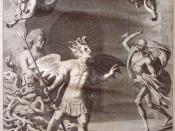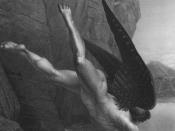The original sin that led to humanity's fall in the Garden of Eden is by far the worst sin committed by humankind. It is this sin that led to future sins. This original sin must be emphasized by writers to depict the evil involved in it. In writing Paradise Lost, John Milton recognizes this fact and uses a variety of literary techniques to stress the evil in the story over the good. The techniques used include a series of parallels with the parallel between good and evil being first and foremost as well, as symmetry to keep the poem in balance. Paradise Lost is a poem essentially about the origin of sin and evil, as a result, Milton presents evil in a more coercive manner than good.
Satan and his followers in Paradise Lost are presented as being more evil than God and his disciples are good. God addresses the Son to be in the likeness of himself in Book three by saying, 'The radiant image of his glory sat, his only Son.'(Bk.
3, 63-64). Although this implies that the Son is a model of perfection as is God, it does not clarify it by stating it outright. Milton definitely portrays Satan's evil in Book four by asserting that Satan is hell and that evil is his good because good has been lost to him. (Bk. 4, lines 75, 108-110). Satan's moral state further decays in Book nine as detailed in a soliloquy at the beginning of the book by Satan. Satan recognizes his descent into bestiality after once being in contention with the gods to sit on top of the hierarchy of angels. He is unhappy with this 'foul descent' and in turn wants to take out his grief on humanity. Despite recognizing that revenge eventually becomes bitter,


